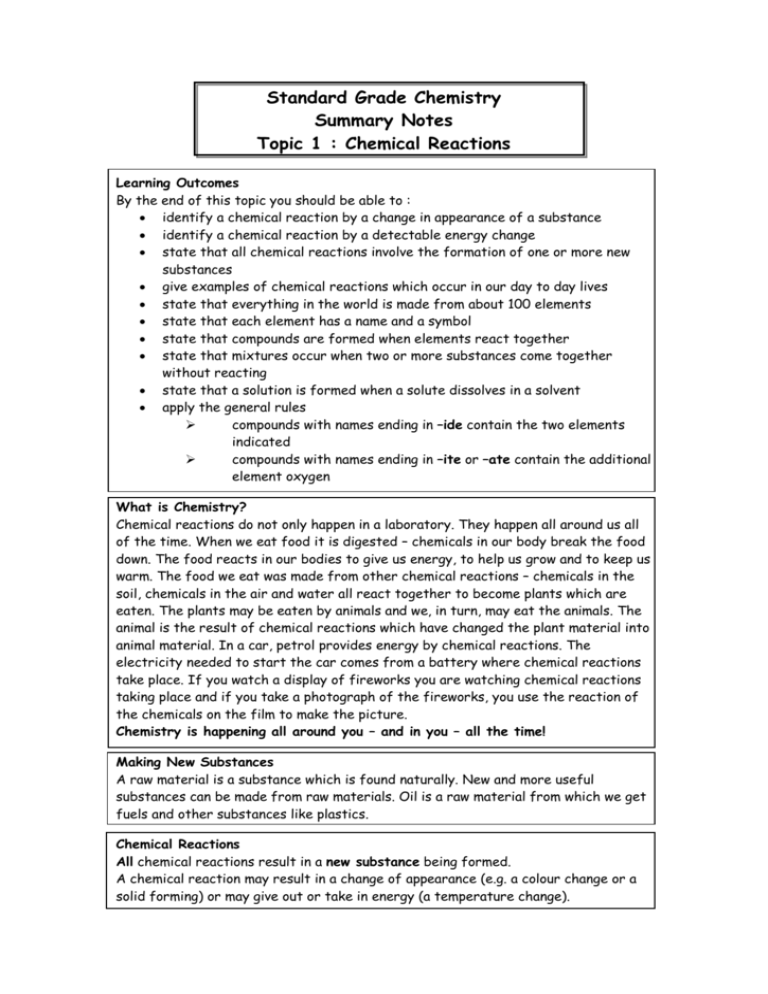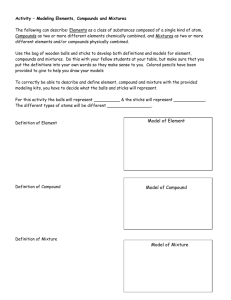Standard Grade Chemistry
advertisement

Standard Grade Chemistry Summary Notes Topic 1 : Chemical Reactions Learning Outcomes By the end of this topic you should be able to : identify a chemical reaction by a change in appearance of a substance identify a chemical reaction by a detectable energy change state that all chemical reactions involve the formation of one or more new substances give examples of chemical reactions which occur in our day to day lives state that everything in the world is made from about 100 elements state that each element has a name and a symbol state that compounds are formed when elements react together state that mixtures occur when two or more substances come together without reacting state that a solution is formed when a solute dissolves in a solvent apply the general rules compounds with names ending in –ide contain the two elements indicated compounds with names ending in –ite or –ate contain the additional element oxygen What is Chemistry? Chemical reactions do not only happen in a laboratory. They happen all around us all of the time. When we eat food it is digested – chemicals in our body break the food down. The food reacts in our bodies to give us energy, to help us grow and to keep us warm. The food we eat was made from other chemical reactions – chemicals in the soil, chemicals in the air and water all react together to become plants which are eaten. The plants may be eaten by animals and we, in turn, may eat the animals. The animal is the result of chemical reactions which have changed the plant material into animal material. In a car, petrol provides energy by chemical reactions. The electricity needed to start the car comes from a battery where chemical reactions take place. If you watch a display of fireworks you are watching chemical reactions taking place and if you take a photograph of the fireworks, you use the reaction of the chemicals on the film to make the picture. Chemistry is happening all around you – and in you – all the time! Making New Substances A raw material is a substance which is found naturally. New and more useful substances can be made from raw materials. Oil is a raw material from which we get fuels and other substances like plastics. Chemical Reactions All chemical reactions result in a new substance being formed. A chemical reaction may result in a change of appearance (e.g. a colour change or a solid forming) or may give out or take in energy (a temperature change). Building Blocks Chemistry is about substances and the way they behave. There are countless different substances and materials in the world. Although there are so many different substances, they are actually made up of a few very basic substances. These basic substances are called elements. Each element is made of only one kind of atom. Its atoms are different from the atoms of other elements. Uses of Elements Different elements have different properties. This means that different elements have different uses. Gold is used for jewellery because it does not corrode. Helium is used in balloons because it is lighter than air. Chemical Symbols Each element has a name of its own. In order to save time it is useful to have a shorthand way of writing the name of each element. We use symbols to do this. A symbol usually consists of the first one or two letters of the name of the element. Sometimes it is the first one or two letters of the old name of the element. Symbols for the elements are found on the Periodic table and in the data booklet. Compounds When atoms of elements combine together compounds are formed. The name of the compound tells us what elements have combined together. (elements) (elements) (elements) copper + oxygen copper oxide sodium + sulphur sodium sulphide calcium + chlorine calcium chloride (compound) (compound) (compound) If a compound’s name ends in –ide, this usually tells us that the compound contains only two elements. We can tell these elements are by looking at the name of the compound. Copper chloride contains the elements copper and chlorine. Potassium nitride contains the elements potassium and nitrogen. The exception to this are compounds containing hydroxide which is made of hydrogen and oxygen. If a compound’s name ends in –ite or –ate, this tells us that the compound contains oxygen as well as other elements. Sodium sulphite contains the elements sodium, sulphur and oxygen. Potassium nitrate contains the elements potassium, nitrogen and oxygen. Making And Breaking Compounds Energy is often given out (exothermic) when a compound is made from its elements. Energy is always needed to break up a compound into its elements. Mixtures When we put substances together they may or may not react together. If they react together, they form a compound. If they do not react together, we have a mixture. It is not easy to separate the elements of a compound from each other because they have combined or joined with each other. The atoms are firmly attached to each other. It is much easier to separate the substances in a mixture because they have not combined with each other. Usually it is possible to separate the substances in a mixture by quite simple means. Separating Mixtures Mixtures can usually be separated, sometimes quite easily. Filtration is used to separate a solid from a liquid. Distillation is used to separate a mixture of liquids with different boiling points. Dissolving Sugar is a solid which will dissolve in the water of your tea. Sugar is said to be soluble in water. A solid substance dissolves in a liquid to form a solution. The solid which dissolve sis called the solute. The liquid which does the dissolving is called the solvent. solute + solvent salt water salt + water salt water When a substance dissolves in a solvent to form a solution, no new substance is formed – solutions are mixtures. Concentration Of Solutions If there is not very much solute in the solution, we say that we have a dilute solution. If there is a lot of solute dissolved in the solution, we say that we have a concentrated solution. If there is so much solute dissolved in the solution that no more can dissolve we say that we have a saturated solution. If we add more solute to a saturated solution it will not dissolve. It will simply lie at the bottom of the beaker. Even stirring will not make any more dissolve. The solution can take no more of that solute.







